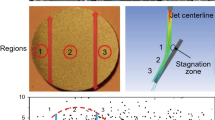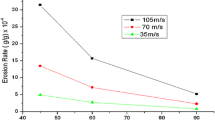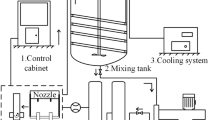Abstract
The essence of erosion is the dynamic damage and material loss process of a material caused by particle impact. The failure mechanism of erosion is the result of the interaction of multiphase flow, particle characteristics, material properties, particle impact process, and other factors. This paper employs experimental and numerical simulation methods to investigate the erosion behavior of a solid-liquid two-phase flow of 316L stainless steel jet from the angle of erosion, to explain the erosion behavior from both macroscopic and microscopic perspectives. The results discovered that the kinetic energy of the fluid is converted into pressure potential energy, which changes the kinematic characteristics of the particles and influences how they erode. The particles erode the target material by plowing and impacting at various erosion angles, and the erosion rate exhibits an increasing-decreasing-increasing tendency as the erosion angle increases, the 45° corresponds to the maximum erosion rate. Due to the particles to harden the target surface, the erosion effect is diminished in the time dimension. Comparing to high erosion angles, the reduction rate of the erosion rate in the late experiment stage is small for slow erosion angles. In the last 3 hours of the experiment, the total erosion of 316L stainless steel at 90° erosion angle was only 35 %. This provides a theoretical foundation for failure prevention in transport components containing solid particles.
Similar content being viewed by others
Abbreviations
- ρ :
-
Density [kg/m3]
- k :
-
Turbulence kinetic energy [m2/s2]
- ε :
-
Rate of dissipation of turbulence kinetic energy [m2/s3]
- S :
-
Source term
- a g :
-
Gas volume fraction
- m :
-
Mass of particle [kg]
- I :
-
Moment of inertia [mm]
- α :
-
Erosion angel [rad]
- H v :
-
Vickers hardness of the material
- D :
-
Particle diameter [mm]
- E :
-
Erosion rate
References
T. S. Eyre and C. Fitter, Application of oil analysis techniques to the study of cylinder liner wear, Wear, 90 (1) (1983) 31–37.
I. Finnie and D. H. Mcfadden, On the velocity dependence of the erosion of ductile metals by solid particles at low angles of incidence, Wear, 48 (1) (1977) 181–190.
W. Huang et al., Effect of flow velocity on erosion-corrosion behaviour of QSn6 alloy, Materials Research Express, 5 (5) (2018) 56525.
B. Liu, L. Bao and A. Xu, Effect of fabric orientation and impact angle on the erosion behavior of high-performance thermoplastic composites reinforced with ductile fabric, Wear, 352–353 (2016) 24–30.
R. S. Lynn, K. K. Wong and H. M. Clark, On the particle size effect in slurry erosion, Wear, 149 (1–2) (1991) 55–71.
R. G. Wellman and C. Allen, The effects of angle of impact and material properties on the erosion rates of ceramics, Wear, 186–187 (3) (1995) 117–122.
B. F. Levin, Effect of mechanical properties on erosion resistance of ductile materials, Ph.D. Thesis, Lehigh University (1998).
I. Finnie and D. H. McFadden, On the velocity dependence of the erosion of ductile metals by solid particles at low angles of incidence, Wear, 48 (1) (1978) 181–190.
J. G. A. Bitter, A study of erosion phenomena part I, Wear, 6 (1) (1963).
J. G. A. Bitter, A study of erosion phenomena: part II, Wear, 6 (3) (1963).
L. Zeng, G. A. Zhang and X. P. Guo, Erosion-corrosion at different locations of X65 carbon steel elbow, Corrosion Science, 85 (2014) 318–330.
B. K. Gandhi and S. V. Borse, Effects of particle size and size distribution on estimating erosion wear of cast iron in sand-water slurries, Indian Journal of Engineering and Materials Sciences, 9 (6) (2002) 480–486.
N. P. Abbade and S. J. Crnkovic, Sand-water slurry erosion of API 5L X65 pipe steel as quenched from intercritical temperature, Tribology International, 33 (12) (2000) 811–816.
Q. B. Nguyen et al., Slurry erosion characteristics and erosion mechanisms of stainless steel, Tribology International, 79 (1) (2014) 1–7.
D. López, J. P. Congote, J. R. Cano, A. Toro and A. P. Tschiptschin, Effect of particle velocity and impact angle on the corrosion-erosion of AISI 304 and AISI 420 stainless steels, Wear, 259 (1–6) (2005) 118–124.
Y. Yang and Y. F. Cheng, Parametric effects on the erosion-corrosion rate and mechanism of carbon steel pipes in oil sands slurry, Wear, 276–277 (2012) 141–148.
G. Ou, K. Bie, Z. Zheng, G. Shu, C. Wang and B. Cheng, Numerical simulation on the erosion wear of a multiphase flow pipeline, International Journal of Advanced Manufacturing Technology, 96 (2018) 1705–1713.
A. Mansouri et al., Improved CFD modeling and validation of erosion damage due to fine sand particles, Wear, 338–339 (2015) 339–350.
M. R. Khan, H. H. Ya and W. Pao, Numerical investigation of the influence of sand particle concentration on long radius elbow erosion for liquid-solid flow, International Journal of Engineering, 32 (10) (2019) 1485–1490.
Z. J. Zheng, Study on the mechanism of multiphase flow erosion wear-cavitation and prediction method for valves with severe working conditions in coal chemical industry, Ph.D. Thesis, Zhejiang University of Technology (2017).
Y. Zhang et al., Comparison of computed and measured particle velocities and erosion in water and air flows, Wear, 263 (1–6) (2007) 330–338.
G. Temple, An Introduction to Fluid Dynamics, An Introduction to Fluid Dynamics, Cambridge University Press (1967).
S. A. Orszag et al., Renormalization group modeling and turbulence simulations, Near-Wall Turbulent Flows (1993).
Z. Y. Zhou et al., Discrete particle simulation of particle-fluid flow: model formulations and their applicability, Journal of Fluid Mechanics, 661 (2010) 482–510.
G. Grant and W. Tabakoff, Erosion prediction in turbomachinery resulting from environmental solid particles, Journal of Aircraft, 12 (5) (1975).
Y. I. Oka, K. Okamura and T. Yoshi Da, Practical estimation of erosion damage caused by solid particle impact part 1: effects of impact parameters on a predictive equation, Wear, 259 (1–6) (2005) 95–101.
Y. I. Oka and T. Yoshida, Practical estimation of erosion damage caused by solid particle impact part 2: mechanical properties of materials directly associated with erosion damage, Wear, 259 (1–6) (2005) 95–101.
N. Wang et al., Effect of grid type on computational efficiency and convergence of flow fields, Journal of Air Force Engineering University (Natural Science Edition), 19 (1) (2018) 9–14.
Acknowledgments
This work was supported by the National Natural Science Foundation of China (No. 52165020), the Ningxia Youth Top Talent Project of China (No. 2020011), and the National Key Research and Development Program of China (No. 2018 YFB2004000).
Author information
Authors and Affiliations
Corresponding author
Additional information
Guan Wang is currently an Associate Professor in the School of Mechanical Engineering, Ningxia University of China. He received his Ph.D. degree from Hunan University of China in 2013. His main research interests include optimization design, numerical simulation of multiphase flow, metal plastic deformation mechanism and multiscale intrinsic structure model.
Rights and permissions
About this article
Cite this article
Wang, G., Gao, Q., Kou, L. et al. Study on liquid-solid jet erosion characteristics of 316L stainless steel. J Mech Sci Technol 37, 1871–1882 (2023). https://doi.org/10.1007/s12206-023-0325-9
Received:
Revised:
Accepted:
Published:
Issue Date:
DOI: https://doi.org/10.1007/s12206-023-0325-9




